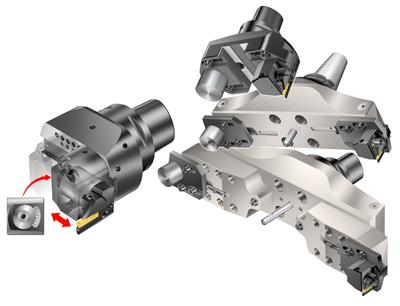
Machine shops seeking competitive gain in face grooving applications should look no further than the new CoroBore 825 SL face grooving heads from Sandvik Coromant. This rotating axial face grooving tool offers a productive alternative to milling grooves for those operating in, or serving sectors such as pumps and valves, hydraulics and the pulp and paper industry.
The solution uses a standard SL32 blade and CoroCut 1-2 inserts, but features through-coolant capability for enhanced chip control. This, in combination with high levels of rigidity, allows increased cutting data.
Chip evacuation is a concern in any metalcutting operation but is critical when grooving because chips are more prone to being trapped inside a groove and being recut. As a result, through-tool coolant delivered right to the cutting edge can be enormously beneficial.
CoroBore 825 SL face grooving heads offer radial fine adjustment for presetting purposes and are available for diameters from 47 to 1275mm. For smaller diameters (1.85 to 5.91"/47-150mm) C6 and C8 adaptors are available, while for larger diameters (greater than 5.91"/150mm) a dedicated face grooving head with CoroBore XL can be deployed.
The first choice insert geometries are -CM for small nose radii (less than 0.0078"/0.2mm) or -TF for larger nose radii (greater than 0.0078"/0.2mm), the recommended starting value for feed rate is 0.006 in/rev (0.15mm/rev). However, if grooves with smaller width tolerances are required -GF geometry is the preferred choice. Here, a feed rate of around 0.004 in /rev (0.10mm/rev) is the recommended starting value.
For applications involving other shapes, such as V-grooves for example, Tailor Made insert solutions are available.
Contact Details
Related Glossary Terms
- coolant
coolant
Fluid that reduces temperature buildup at the tool/workpiece interface during machining. Normally takes the form of a liquid such as soluble or chemical mixtures (semisynthetic, synthetic) but can be pressurized air or other gas. Because of water’s ability to absorb great quantities of heat, it is widely used as a coolant and vehicle for various cutting compounds, with the water-to-compound ratio varying with the machining task. See cutting fluid; semisynthetic cutting fluid; soluble-oil cutting fluid; synthetic cutting fluid.
- feed
feed
Rate of change of position of the tool as a whole, relative to the workpiece while cutting.
- gang cutting ( milling)
gang cutting ( milling)
Machining with several cutters mounted on a single arbor, generally for simultaneous cutting.
- grooving
grooving
Machining grooves and shallow channels. Example: grooving ball-bearing raceways. Typically performed by tools that are capable of light cuts at high feed rates. Imparts high-quality finish.
- metalcutting ( material cutting)
metalcutting ( material cutting)
Any machining process used to part metal or other material or give a workpiece a new configuration. Conventionally applies to machining operations in which a cutting tool mechanically removes material in the form of chips; applies to any process in which metal or material is removed to create new shapes. See metalforming.
- milling
milling
Machining operation in which metal or other material is removed by applying power to a rotating cutter. In vertical milling, the cutting tool is mounted vertically on the spindle. In horizontal milling, the cutting tool is mounted horizontally, either directly on the spindle or on an arbor. Horizontal milling is further broken down into conventional milling, where the cutter rotates opposite the direction of feed, or “up” into the workpiece; and climb milling, where the cutter rotates in the direction of feed, or “down” into the workpiece. Milling operations include plane or surface milling, endmilling, facemilling, angle milling, form milling and profiling.

